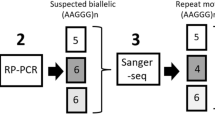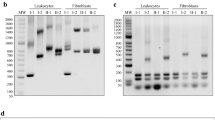Abstract
Friedreich’s ataxia (FRDA) is an autosomal recessive neurodegenerative disorder commonly caused by large expansions of a GAA repeat in the first intron of the frataxin gene, FRDA. The expansion of the triplet repeat is localized within an Alu sequence. FRDA GAA-repeat alleles can be divided into three classes depending on their lengths: short normal alleles (SN), long normal alleles (LN) and expanded pathological alleles (E). We made an accurate analysis of the Alu sequence containing the GAA repeat. We found a new single-nucleotide polymorphism (SNP) that is the closest one to the GAA repeat. We studied this new SNP and the polymorphic polyA region contiguous to the GAA triplets in two populations with different frequencies of FRDA. We found that, while both E and LN alleles seem to be genetically homogeneous and likely related, SN represents a more heterogeneous class of alleles. Indeed, one SNP variation (T) was more frequently associated with (GAA)8 alleles, whereas the other one (C) with (GAA)9 repeat(s). The long normal and expanded alleles presented the C haplotype. The same correlation was described for polyA-tract polymorphisms. Thus, 14A was commonly associated with (GAA)8 alleles and 17A with (GAA)9 alleles. The long normal alleles more frequently showed the 17A haplotype. Our data seem to suggest that all the E alleles come from LN alleles, while LN alleles come from a defined subclass of SN alleles.



Similar content being viewed by others
References
Babcock M, de Silva D, Oaks R, Davis-Kaplan S, Jiralerspong S, Montermini L, Pandolfo M, Kaplan J (1997) Regulation of mitochondrial iron accumulation by Yfh1p, a putative homolog of frataxin. Science 276:1709–1712
Batzer MA, Deininger PL (2002) Alu repeats and human genomics diversity. Nat Rev Genet 3:370–379
Campuzano V, Montermini L, Moltò MD, Pianese L, Cossée M, Cavalcanti F, Monros E, Rodius F, Duclos F, Monticelli A, et al. (1996) Friedreich’s ataxia: autosomal recessive disease caused by an intronic GAA triplet repeat expansion. Science 271:1423–1427
Campuzano V, Montermini L, Lutz Y, Cova L, Hindelang C, Jiralerspong S, Trottier Y, Kish SJ, Faucheux B, Trouillas P, Authier FJ, Dürr A, Mandel JL, Vescovi A, Pandolfo M, Koenig M (1997) Frataxin is reduced in Friedreich ataxia patients and is associated with mitochondrial membranes. Hum Mol Genet 6:1771–1780
Cavadini P, Gellera C, Patel PI, Isaya G (2000) Human frataxin maintains mitochondrial iron homeostasis in Saccharomyces cerevisiae. Hum Mol Genet 9:2523–2530
Chen OS, Hemenway S, Kaplan J (2002) Inhibition of Fe-S cluster biosynthesis decreases mitochondrial iron export: evidence that Yfh1p affects Fe-S cluster synthesis. Proc Natl Acad Sci USA 99:12321–12326
Colombo R, Carobene A (2000) Age of the intronic GAA triplet repeat expansion mutation in Friedreich ataxia. Hum Genet 106:455–458
Cossée M, Schmitt M, Campuzano V, Reutenauer L, Moutou C, Mandel JL, Koenig M (1997) Evolution of the Friedreich’s ataxia trinucleotide repeat expansion: founder effect and premutations. Proc Natl Acad Sci USA 94:7452–7457
Cossée M, Durr A, Schmitt M, Dahl N, Trouillas P, Allinson P, Kostrzewa M, Nivelon-Chevallier A, Gustavson KH, Kohlschutter A, Muller U, Mandel JL, Brice A, Koenig M, Cavalcanti F, Tammaro A, De Michele G, Filla A, Cocozza S, Labuda M, Montermini L, Poirier J, Pandolfo M (1999) Friedreich’s ataxia: point mutations and clinical presentation of compound heterozygotes. Ann Neurol 45:200–206
Epplen C, Epplen JT, Frank G, Miterski B, Santos EJ, Schöls L (1997) Differential stability of the (GAA)n tract in the Friedreich ataxia (STM7) gene. Hum Genet 99:834–836
Filla A, De Michele G, Marconi R, Bucci L, Carillo C, Castellano AE, Iorio L, Kniahynicki C, Rossi F, Campanella G (1992) Prevalence of hereditary ataxias and spastic paraplegias in Molise, a region of Italy. J. Neurol 239:351–353
Harding AE (1981) Friedreich’s ataxia: a clinical and genetic study of 90 families with an analysis of early diagnostic criteria and intrafamilial clustering of clinical features. Brain 104:589–620
Justice CM, Den Z, Nguyen SV, Stoneking M, Deininger PL, Batzer MA, Keats BJ (2001) Phylogenetic analysis of the Friedreich ataxia GAA trinucleotide repeat. J Mol Evol 52:232–238
Labuda M, Labuda D, Miranda C, Poirier J, Soong BW, Barucha NE, Pandolfo M (2000) Unique origin and specific ethnic distribution of the Friedreich ataxia GAA expansion. Neurology 54:2322–2324
Marin-Garcia J, Goldenthal M J, Filiano JJ (2002) Cardiomyopathy associated with neurologic disorders and mitochondrial phenotype. J Child Neurol 17:759–765
Montermini L, Andermann E, Labuda M, Richter A, Pandolfo M, Cavalcanti F, Pianese L, Iodice L, Farina G, Monticelli A, Turano M, Filla A, De Michele G, Cocozza S (1997) The Friedreich ataxia GAA triplet repeat: premutation and normal alleles. Hum Mol Genet 6:1261–1266
Muhlenhoff U, Richhardt N, Gerber J, Lill R (2002) Characterization of iron-sulfur protein assembly in isolated mitochondria. A requirement for ATP, NADH, and reduced iron. J Biol Chem 277:29810–29816
Mukerji M, Choudhry S, Saleem Q, Padma M V, Maheshwari M C, Jain S (2000) Molecular analysis of Friedreich’s ataxia locus in the Indian population. Acta Neurol Scand 102:227–229
Palau F (2001) Friedreich’s ataxia and frataxin: molecular genetics, evolution and pathogenesis Int J Mol Med 7:581–589
Pianese L, Busino L, De Biase I, De Cristofaro T, Lo Casale MS, Giuliano P, Monticelli A, Turano M, Criscuolo C, Filla A, Varrone S, Cocozza S (2002) Up-regulation of c-Jun N-terminal kinase pathway in Friedreich’s ataxia cells. Hum Mol Genet 11:2989–2996
Rötig A, de Lonlay P, Chretien D, Foury F, Koenig M, Sidi D, Munnich A, Rustin P (1997) Aconitase and mitochondrial iron-sulphur protein deficiency in Friedreich ataxia. Nat Genet 17:215–217
Wong A, Yang J, Cavadini P, Gellera C, Lonnerdal B, Taroni F, Cortopassi G (1999) The Friedreich’s ataxia mutation confers cellular sensitivity to oxidant stress which is rescued by chelators of iron and calcium and inhibitors of apoptosis. Hum Mol Genet 8:425–430
Yoon T, Cowan JA (2003) Iron-sulfur cluster biosynthesis. Characterization of frataxin as an iron donor for assembly of [2Fe-2S] clusters in ISU-type proteins. J Am Chem Soc 125:6078–8604
Zuhlke C, Gehlken U, Purmann S, Kunisch M, Muller-Myhsok B, Kreuz F, Laccone F (1999) Linkage disequilibrium and haplotype analysis in German Friedreich ataxia families. Hum Hered 49:90–96
Acknowledgements
We would like to thank the families for their participation.
Author information
Authors and Affiliations
Corresponding author
Rights and permissions
About this article
Cite this article
Monticelli, A., Giacchetti, M., De Biase, I. et al. New clues on the origin of the Friedreich ataxia expanded alleles from the analysis of new polymorphisms closely linked to the mutation. Hum Genet 114, 458–463 (2004). https://doi.org/10.1007/s00439-004-1089-7
Received:
Accepted:
Published:
Issue Date:
DOI: https://doi.org/10.1007/s00439-004-1089-7




